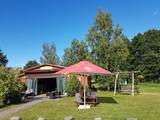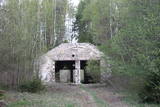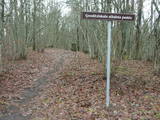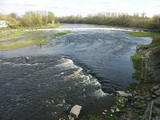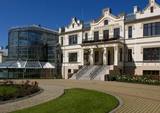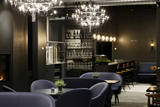| Nr | Nosaukums | Apraksts |
|---|---|---|
|
Kafejnīca "Stieres" atrodas Jūrmalas – Kolkas ceļa (P 131) malā – kempinga „Stieres” teritorijā. Piedāvā mājas virtuvi visām ēdienreizēm. Maltīti gatavo no Latvijas zemnieku audzētiem dārzeņiem, salātiem, zaļumiem. Zivju ēdieni ir no vietējo zvejniecības uzņēmumu ķertā vai pārstrādātā loma. Piedāvā dažādu svinību galdu klāšanu. Latviešu virtuve: Aukstā zupa, siļķe ar kartupeļiem un biezpienu, kartupeļu un plānās pankūkas, rosols, vietējo zemeņu zupa.
|
||
|
Grūti pieejamā un atrodamā vietā - dziļos Bārtas mežos izvietota bijusī Plāņciema raķešu bāze, īpašs bijušais PSRS militārais objekts. Milzīga teritorija ar atsevišķiem sektoriem, kurus savieno betonēti ceļi. Redzami arī raķešu palaišanas laukumi. Tā kā teritorija netiek apsaimniekota un tajā "darbojas" bebri, apkārtne pamazām pārpurvojas. Varēja būt iespaidīgs tūrisma objekts, ja par to tiktu domāts jau senāk. Bāzes objekti daļēji ir nojaukti būvmateriālu ieguvei.
|
||
|
Ja jums patīk aktīvs dzīvesveids, šī ekskursija ir ideāls veids, kā izbaudīt kulināro mantojumu, kas slēpjas Gaujas Nacionālajā parkā. Velomaršruts sākas no Strenčiem un vispirms ved caur divām vietējām alus darītavām Brenguļos un Valmiermuižā ar jaukām kafejnīcām un labu alu. Ceļā uz Valmieru apstāsieties arī Trikātas ciematā, lai nobaudītu vietēji gatavoto šokolādi. No Valmieras maršruts ved cauri skaistam mežam uz Cēsīm un tur esošo burvīgo viduslaiku vecpilsētu. Cēsīs apmeklēsiet vietējo maiznīcu un spirta rūpnīcu, lai nobaudītu produkciju. Jūs redzēsiet arī to, kā viduslaikos izskatījās ārstniecības un garšaugu dārzs. Brauksiet ar kanoe no Cēsīm uz Līgatni, kas ir viena no Gaujas skaistākajām vietām ar tās smilšakmens krastiem, attālām lauku viensētām un vecmodīgu ūdensdarbināmu prāmi. Līgatnes pilsētas vēsturiskais centrs ir saistīts ar tās papīrfabrikas attīstību. Šeit iespējams apmeklēt arī vietējos vīna un rokdarbu ražotājus vienā no apgabalam raksturīgajām mākslīgajām alām. Pārvietojoties pa kalnainajiem, līkumotajiem Siguldas ceļiem, redzēsiet Turaidas un Siguldas viduslaiku pilis, Gūtmaņala alu un citus gleznainus skatus. Siguldā baudīsiet latviešu tradicionālos ēdienus restorānos “Bucefāls”, “Aparjods” un viesu namā “Mauriņi” nobaudīsiet 80 ievārījumu veidus. |
||
|
Viesītes muzeju “Sēlija” veido 2 nodaļas – Mazā Bānīša parks un Paula Stradiņa skola. Ekspozīcijas vēstī par Sēlijas šaursliežu dzelzceļa vēsturi, Sēlijas kultūrvēsturi, Stradiņu dzimtu, medicīnas vēsturi Viesītes apkārtnē, Stenderu dzimtu, amatniecību, Viesītes pilsētas un tuvākās apkārtnes vēsturi un ļaudīm. Muzejs izveidots 2000. gadā un tā nozīmīga ekspozīcijas daļa atrodas bijušā šaursliežu dzelzceļa depo ēkā (dzelzceļš darbojās laikā no 1916. – 1972. g.), kur novietota atjaunotā lokomotīve, pasažieru vagons, drezīna u.c. Muzejā apskatāmi eksponāti, kas atspoguļo Viesītes un plašākas teritorijas ievērojamāko personību dzīves gājumu, notikumus un kultūras mantojumu. |
||
|
Nelielā izmēra ēka (balts ķieģeļu mūris, ar dēļiem apšūts zems tornis) atrodas Liepājas – Klaipēdas šosejas (A 11) malā. 20. gadsimta sākumā tā kalpojusi kā lūgšanu nams, taču tā paša gadsimta vidū pārbūvēta, uzceļot torni. |
||
|
Idumejas augstienes augstākais reljefa virsmas punkts - Zilais kalns ir izteikts ar mežu apaudzis lielpaugurs, no kura paveras telpiski „šaura” ainava uz augstienes ziemeļdaļu un Burtnieka līdzenumu. Liegums veidots aizsargājamu biotopu – gravu, nogāžu un boreālo (ziemeļu) mežu, kā arī atsevišķu sugu aizsardzībai. Zilais kalns ir arī populārs tūrisma objekts, tā piekājē izveidota autostāvvieta. Teritorija no tūrisma viedokļa ir labiekārtota
|
||
|
Saimniecībā notiek izglītojošās programmas, kuru laikā apmeklētāji tiek iepazīstināti ar saimniecībā dzīvojošajiem dzīvniekiem, to kopšanu un šķirņu izcelsmi. Apmeklētājiem ir iespēja pašiem savākt olas, iemācīties taisni sēdēt seglos un pajāt. |
||
|
Vairākas ēkas, kurās var iepazīt Vidzemes lībiešu vēsturi un kultūras mantojumu, izbaudot novadam kādreiz raksturīgos ēdienus un dzērienus – bukstiņbiezputru un škaļiku, kas ir pēc senām receptēm darināts stiprs alkoholisks dzēriens. Tūristu grupas īstā lauku krāsnī var izcept rupjmaizi, bet audēju namiņā – vērot audēju darbošanos un iegādāties no dabīgiem materiāliem (t.sk. meldriem) darinātas praktiskas lietas un suvenīrus. Latviešu virtuve: Putraimu putra ar gruzdumiem (sacepti gaļas kriksīši ar sīpoliem) un dzērveņu - brūkleņu zapti vai mērci, zāļu tēja ar dzērveņu sīrupu, škaļiks - alkoholisks dzēriens. |
||
|
Veikals "Zaļā Zeme" piedāvā bioloģiskās lauksaimniecības produktus un dabīgus pārtikas produktus, veselīgus produktus bērniem, bezglutēna produktus, ekoloģisku kosmētiku un tīrīšanas līdzekļus. Piedāvājumā Latvijas zemnieku un mājražotāju produkcija, kas gatavota no dabīgām izejvielām. |
||
|
Atrodas Lielvārdes parkā, blakus Andreja Pumpura Lielvārdes muzejam. Tagad redzamais dievnams atjaunots 1932. g. – iepriekšējās - 1747. g. būvētās un 1. pasaules kara laikā sabombardētās baznīcas vietā. No ēkas interjera ir jāpiemin vairāki mākslas pieminekļi: altāris, kancele, baznīcēnu soli, Kārļa Miesnieka altārglezna “Jēzus Ģetzemanes dārzā” (1939. g.). Pie baznīcas austrumu sienas apskatāms zemē daļēji iegrimis akmens krusts – t.s. Krustakmens. Uzskata, ka tas ir sens kapakmens. |
||
|
Viesu māja Sila ezera krastā. Vasaras māja, atsevišķā ēkā pirts un atpūtas telpa ar kamīnu. Pirts mājā - kamīnistaba, pirts, duša, 2-vietīga guļamistaba. Vasaras mājā - viena istaba ar 2 atsevišķām gultām, sausā tualete. Makšķerēšanas iespējas, laivas, ugunskura un telšu vietas. |
||
|
Bistro un konditoreja - kafejnīca "Silva" atrodas Jelgavas pilsētas centrā. Vasarā ir pieejama āra terase. Cep svaigas smalkmaizītes, kūkas, kliņģerus, plātsmaizes, pīrādziņus un cepumus. Sadarbojas ar vietējiem ražotājiem. Latviešu virtuve: Speķa pīrādziņi, kartupeļu pankūkas, miežu – kartupeļu biezputra ar speķa mērci, uzpūtenis ar pienu. Ziemas saulgriežu laikā – pelēkie zirņi ar speķi. Īpašais ēdiens: „Hercoga bura” – krāsnī cepta cūkgaļa ar karamelizētiem skābētiem kāpostiem, ceptiem dārzeņiem un saknēm, brūkleņu biezeni un mārrutkiem. |
||
|
Restorāns "Light House Jūrmala" atrodas jūras krastā ar visaptverošu skatu uz Jūrmalu. Grila terase uzbūvēta stilizēta kuģa stūres formā. Sadarbojas ar vietējiem zemniekiem un zvejniekiem. Latviešu virtuve: Aukstā biešu zupa, zivju zupa, kūpināts zutis ar lauku krējumu, pīles aknas, kartupeļu biezeņzupa ar gailenēm, cepts zandarts, brieža mugura sinepju mērcē. |
||
|
Ventas ielejas posms augšpus un lejpus Kuldīgas, kas izceļas ar dažādu biotopu – nogāžu mežu, smilšakmens un dolomīta atsegumu, pļavu, aizsargājamu augu un dzīvnieku sugu un ainavas daudzveidību. Teritorijā atrodas populāri Kurzemes tūrisma objekti – Ventas rumba, Kuldīgas mūra tilts, Veckuldīgas pilskalns (labiekārtots) u.c. Ventas krastos izveidota ekotūrisma taka "Ventas līkloči", uzcelts skatu tornis, izvietoti informācijas stendi, bet gar upes kreiso krastu ierīkots velomaršruts. |
||
|
Restorāns "Kungu rija" atrodas Turaidas – Raganas ceļa malā. Rijas celtniecība (2004. g.) notikusi pēc vēsturiskajām tradīcijām kā liecība par barona Holšteina būvēto Turaidas muižas riju. Latviešu virtuve: Kūpināts sams, jēra ciska, teļa, brieža vai cūkas cepetis, pildīta pīle vai zoss. |
||
|
Muižas komplekss sāka veidoties 15. gs. beigās, - 16. gs. sākumā. Ievērojamas izmaiņas norisinājās 19. gs., kad tā kļuva par grāfa Tiškeviča īpašumu. 1875. g. iekārtotais Ziemas dārzs ir lielākais Austrumeiropā. Kretingas muižas parks – viens no senākajiem Lietuvā 16. – 17.gs. muižas parkiem, kas saglabājies līdz mūsdienām. Tas ir jaukta stila parks, aptverot 23 ha laukumu. Kretingas muižas dienvidu daļā, bijušajā augļu dārza vietā atrodams Astronomiskais kalendārs ar Saules pulksteni, iekopts dzīvžogs, alejas, puķu dobes un akmeņdārzi ar rūpīgi iekoptām dāliju, peoniju, tulpju un rožu kolekcijām, gājēju taciņas, atpūtas laukumi. Atjaunotā muižas strūklaka kļuvusi īpaši pilsētas viesu iemīļota atpūtas vieta. |
||
|
Apriņķa muzeja galvenajā ēkā (atvērta visu gadu) un tā filiālēs (atvērtas vasaras sezonā) varat iepazīties ar Hījumā salas, piekrastes zvejniecības, lauksaimniecības un muižu vēsturi, ar cara un Igaunijas brīvvalsts laikiem, Kerdlas Kaleva fabriku, padomju laikiem, kā arī uzzināt daudz citu izzinošu informāciju. Garajā mājā (Pikk Maja) iespējams organizēt kultūras mantojuma stundas. |
||
|
Vecākais un lielākais Lietuvas kūrorts (no 1794. g.). Mikroklimats (apkaimes mežu gaiss), sāli saturoši avoti, dūņas. Vecpilsēta – pilsētbūvniecības piemineklis. |
||
|
Ceļojumā apskatīsiet slaveno Lietuvas Krusta kalnu, Kauņas vecpilsētu, no skatu vietām vai izbraucot ar kuģīti vērosiet krāšņās Nemunas upes lokus. Kūrortpilsētā Druskininkos apmeklēsiet Grūtu parku ar “ļeņinekļiem”, piedzīvojot aizgājušos „Padomju laikus”. Iespēja izvizināties ar velosipēdu pa vienu no visneskartākajām dabas teritorijām Baltijā Dzūkijas nacionālo parku. Vakarā varēsiet baudīt kādu no izvēles SPA procedūrām vai izpriecāties lielajā Druskininku ūdens atrakciju parkā. |
||
|
Zoltners ir vieta, kur laika plūdums kļūst nebūtisks. Miers un atmosfēra, ko veido apkārtnes lauku ainava un pārdomātā arhitektūra, ir izcila vide, kurā aizmirst pilsētas rūpes un steigu. Šis gads iesācies ar pārmaiņām Zoltners restorānā. No februāra garšas piedzīvojumus turpinām ar jaunu šefpavāru Nauri Malāhovu. Nauris ir svaiguma un vietējo produktu piekritējs – spēj radīt esenci no labākā, ko var sniegt katra sezona. Baudu no garšas uzskata par savu misiju. Ēdienkarte veidota no atlasītiem ēdieniem, lai katram var pievērsties kā mākslas darbam. Garša ir dabiska - tīra un īsta, papildināta ar akcentiem, kas saskan, nekā lieka. Kad virtuvē darbojas jauns pavārs, tad viesošanās restorānā ir pavisam jauna pieredze. Tas ir tikpat kā apmeklēt jaunu restorānu. |
||
